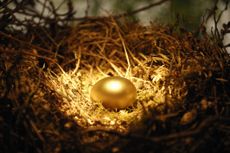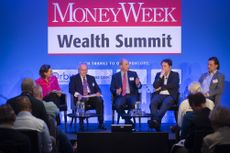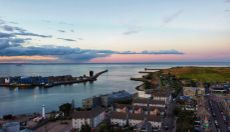Market crash: have we hit bottom or is there worse to come?
For a little while, markets looked like they were about to embark on a full-on crash. And that could still happen, says Dominic Frisby. Today, he looks back at previous crashes to see what they can teach us about where things might go next.


A week or so ago, the selling action in the stockmarket had grown so bad that a number of folks thought a crash was back on the cards.
Market crashes don’t come along often
Crashes are rare events – the 21st century has seen two so far. That’s rather a lot by the standards of the previous century, when there were perhaps five or six in the US over the course of 100 years – 1907, 1929, 1937, 1962, 1987 and 1990.
It depends how you define crash, of course; you could argue there were just three. So crashes don’t happen often. The probability is, then, that if you forecast or expect them, you are going to be wrong.
Subscribe to MoneyWeek
Subscribe to MoneyWeek today and get your first six magazine issues absolutely FREE

Sign up to Money Morning
Don't miss the latest investment and personal finances news, market analysis, plus money-saving tips with our free twice-daily newsletter
Don't miss the latest investment and personal finances news, market analysis, plus money-saving tips with our free twice-daily newsletter
Even the great short sellers who made fortunes during crashes – Jesse Livermore in 1929, Stanley Druckenmiller in 2008 – will tell you that 90% of their fortunes were made on the long side, especially in growth stocks (that’s what Druckenmiller says, at least).
Yet, a bit like ghosts and UFO landings, stockmarket crashes make for good copy; predicting crashes gets you lots of clicks and lots of followers. I think we all have an innate obsession with them. The thought of a crash and losing everything lingers at the back of every investor’s mind, the worst-case scenario.
But selling pressure got so extreme that it really started to feel like a full-on crash could be on the cards. Stockmarkets have rallied a bit now, so the pressure has eased and it feels like they are going to rally a bit further. But a week ago, I can tell you, I was feeling the heat, and I bet you were too.
What triggered me was a recollection of 2008, when markets had been in abject decline for some months, but the oil price kept rising. It made its way all the way to $150 a barrel or thereabouts in July of that year, before capitulating along with everything else by the autumn.
It occurred to me that something similar was happening this year: markets generally were declining, while the oil price kept on rising on its march to $130.
Oil price surges are driven by genuine demand, but there is always a lot of hot speculative money in there as well, which means the rises and the sell-offs are always a bit more racy than perhaps they otherwise would be.
What previous crashes can tell us about what might happen next
In any case, history often rhymes, as the saying goes, and so there is some value to fractal patterns – that is, looking for similar price patterns from different periods – if you are looking to ascertain how likely certain outcomes are.
I spent some time at the weekend comparing the price action of various asset prices in the lead up to the crashes of 2000 and 2008 – the S&P 500, gold, copper, Brent crude oil and the long bond (using the exchange-traded fund TLT) – compared to the price action of late.
I’m not going to post a chart as there are too many squiggly lines and it’s confusing. But the sequence has been as follows: TLT (bonds) made a high at the beginning of December 2021, then relentlessly declined. Stockmarkets (S&P 500) peaked at the beginning of January 2022, then relentlessly declined.
Oil, gold and copper all peaked in March, with gold and copper all going into relentless decline. Oil then had another rally and peaked in early June. Now we are having a relief rally in stocks (or have we seen the low?).
So to summarise – bonds, then stocks, then precious and base metals, then oil. Then a relief rally in stocks.
Turning to 2008, bonds rallied as everything else crashed, so there is no correlation. But otherwise the sequence is similar.
Stocks peaked in October 2007, then gold and copper peaked in March 2008. Gold then fell, but copper had another rally, eventually peaking with oil in July. Then they began their fall. Stocks had a relief rally for a couple of months, then in September we went into global free fall.
Bonds aside then, the sequence is similar enough to be concerning.
In 2000, bonds peaked over a year ahead of stocks, declined, but then rallied as stocks fell. Gold peaked six months ahead of stocks – which peaked in March 2000. (Gold was at the end of its worst bear market ever, so I am not even sure comparisons are valid here). But then copper and oil peaked shortly after stocks re-tested their highs in October 2000.
So leaving aside bonds, there is a definite sequence of stocks peaking, followed by base metals and oil a few months after, then the big declines.
We are following a similar sequence now.
Sentiment was so low last week and markets were so oversold that there is a part of me that thinks we have already seen the low. But I’m also conscious that a relief rally in stocks now, with weakness in metals and energy, is worryingly close to the 2008 crash template and, to an extent, the 2000 template.
So maybe it’s not time to bet the house just yet.
Dominic’s film, Adam Smith: Father of the Fringe, about the unlikely influence of the father of economics on the greatest arts festival in the world is now available to watch on YouTube.
Dominic Frisby (“mercurially witty” – the Spectator) is the world’s only financial writer and comedian. He is MoneyWeek’s main commentator on gold, commodities, currencies and cryptocurrencies. He is the author of the books Bitcoin: the Future of Money? and Life After The State. He also co-wrote the documentary Four Horsemen, and presents the chat show, Stuff That Interests Me.
His show 2016 Let’s Talk About Tax was a huge hit at the Edinburgh Festival and Penguin Random House have since commissioned him to write a book on the subject – Daylight Robbery – the past, present and future of tax will be published later this year. His 2018 Edinburgh Festival show, Dominic Frisby's Financial Gameshow, won rave reviews. Dominic was educated at St Paul's School, Manchester University and the Webber-Douglas Academy Of Dramatic Art.
You can follow him on Twitter @dominicfrisby
-
 Private school fees soar and VAT threat looms – what does it mean for you?
Private school fees soar and VAT threat looms – what does it mean for you?Rising private school fees could see more than one in five parents pull their children out of their current school. Before you remortgage, move house or look to grandparents for help, here’s what you need to know.
By Katie Williams Published
-
 Best and worst UK banks for online banking revealed
Best and worst UK banks for online banking revealedWhen it comes to keeping your money safe, not all banks are equal. We reveal the best and worst banks for online banking when it comes to protecting your money from scams
By Oojal Dhanjal Published
-
 Halifax: House price slump continues as prices slide for the sixth consecutive month
Halifax: House price slump continues as prices slide for the sixth consecutive monthUK house prices fell again in September as buyers returned, but the slowdown was not as fast as anticipated, latest Halifax data shows. Where are house prices falling the most?
By Kalpana Fitzpatrick Published
-
 Rents hit a record high - but is the opportunity for buy-to-let investors still strong?
Rents hit a record high - but is the opportunity for buy-to-let investors still strong?UK rent prices have hit a record high with the average hitting over £1,200 a month says Rightmove. Are there still opportunities in buy-to-let?
By Marc Shoffman Published
-
 Pension savers turn to gold investments
Pension savers turn to gold investmentsInvestors are racing to buy gold to protect their pensions from a stock market correction and high inflation, experts say
By Ruth Emery Published
-
 Where to find the best returns from student accommodation
Where to find the best returns from student accommodationStudent accommodation can be a lucrative investment if you know where to look.
By Marc Shoffman Published
-
 Best investing apps
Best investing appsWe round up the best investing apps. Looking for an easy-to-use app to help you start investing, keep track of your portfolio or make trades on the go?
By Ruth Emery Last updated
-
 The world’s best bargain stocks
The world’s best bargain stocksSearching for bargain stocks with Alec Cutler of the Orbis Global Balanced Fund, who tells Andrew Van Sickle which sectors are being overlooked.
By Andrew Van Sickle Published
-
 Revealed: the cheapest cities to own a home in Britain
Revealed: the cheapest cities to own a home in BritainNew research reveals the cheapest cities to own a home, taking account of mortgage payments, utility bills and council tax
By Ruth Emery Published
-
 UK recession: How to protect your portfolio
UK recession: How to protect your portfolioAs the UK recession is confirmed, we look at ways to protect your wealth.
By Henry Sandercock Last updated